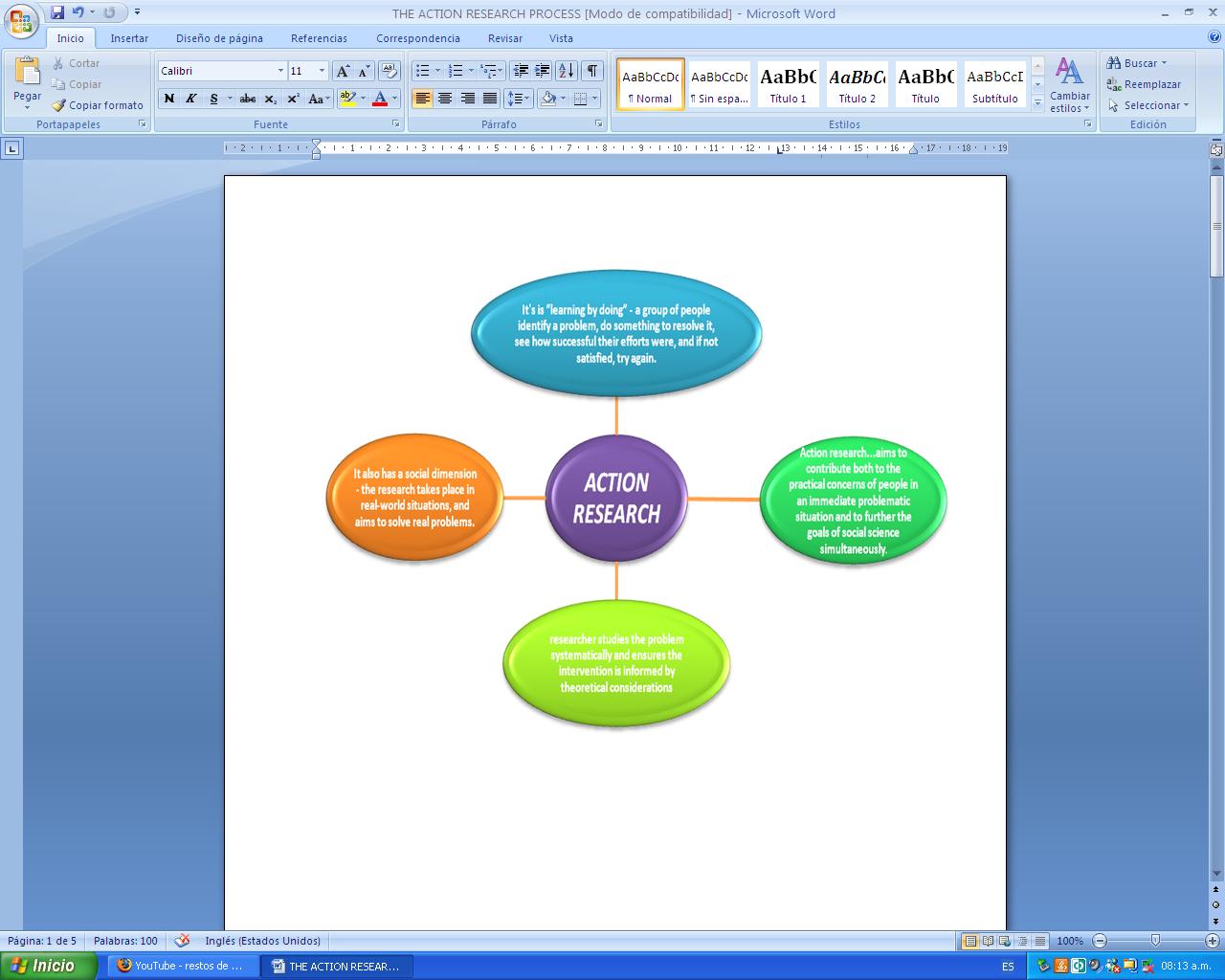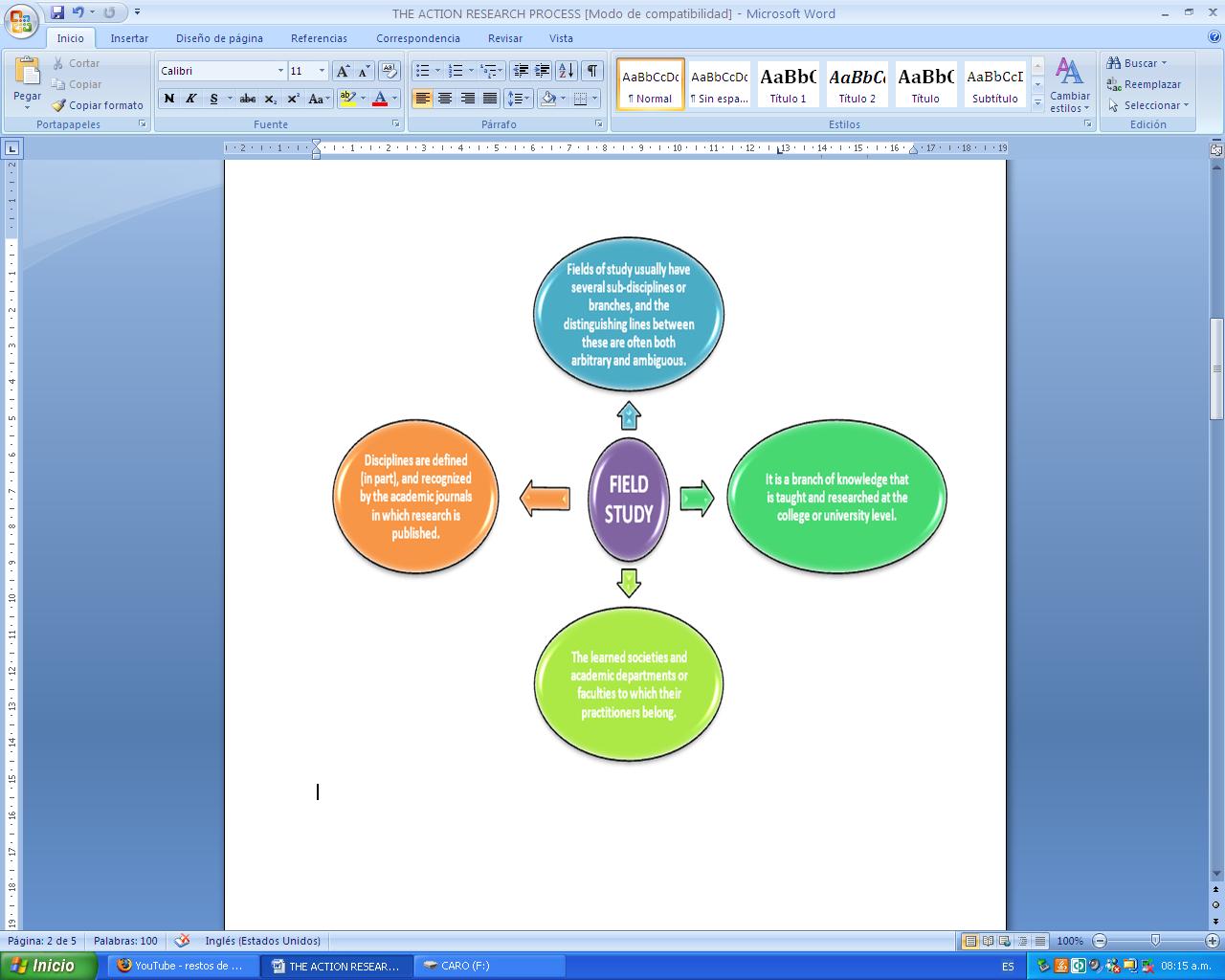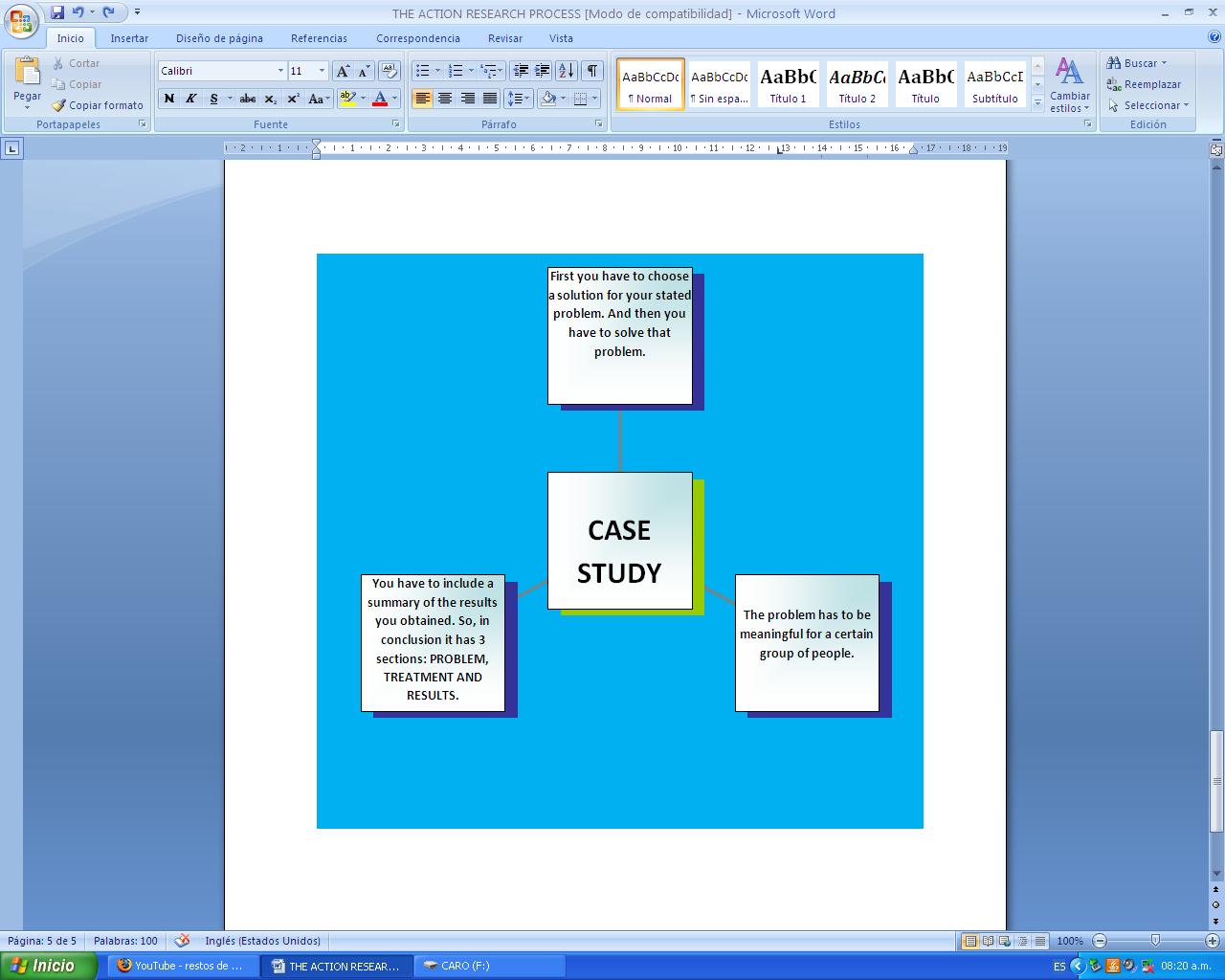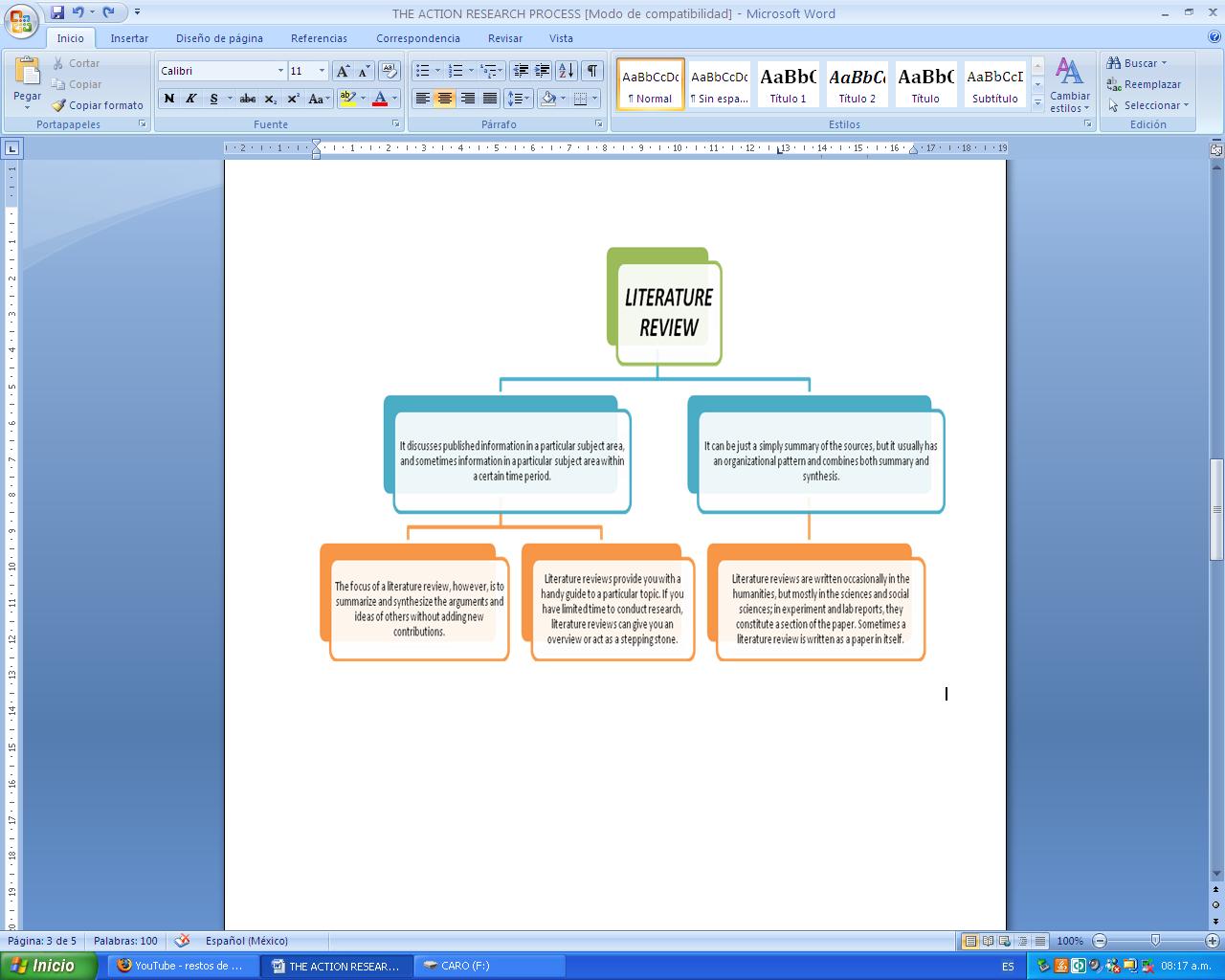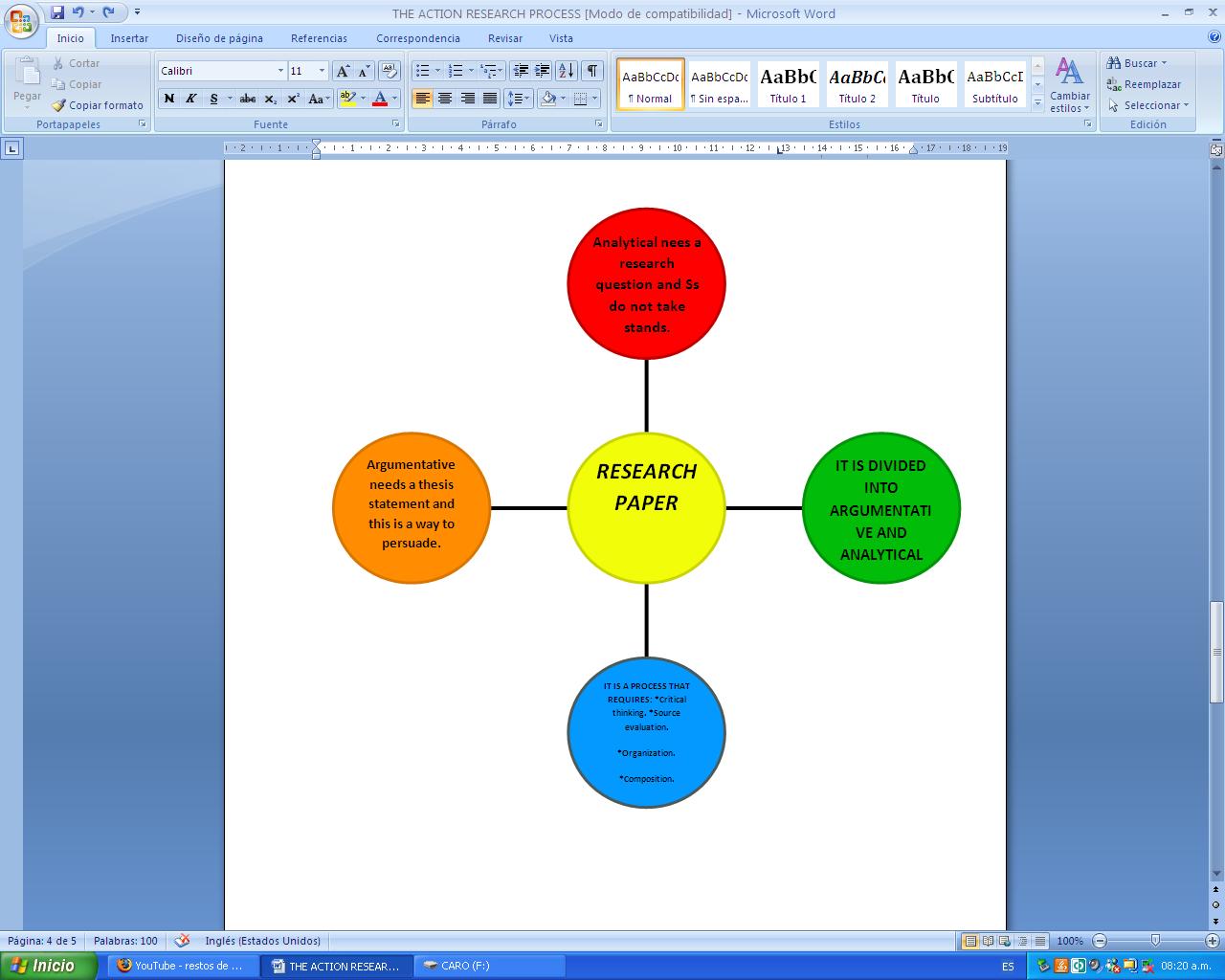User:CaroMaya/academic writing notes
Contents
CARO´S NOTES
Headline text
Headline text
Headline text
Headline text
THE VISIT TO CAADI (September 14th, 2010)
TYPES OF WRITING: 1. Narration.- It is an account of an audienre or a serious of incidents that make up a complete and significant action. Each narrative has 5 properties: situation, conflict, struggle, outcome and meaning.
2. Descriptive.- The use of words to represent the appearance of something. Description is divided into 2 types: objective and subjective.
3. Exemplification.- We use examples, convince and amuse. This is the most common type of writing and the examples can be only phrases and single words.
4. Process/Analysis.- If you need to explain how to do something into stages and there are two types: directive and informative.
5. Cause and Effect.- This describes the sequence of events and this is necesarily by exploring.
6. Comparison and Contrast.- This is by showing similarities or dis-similarities between subjects. And it has to do with organizing and development dissimilarity.
UNIT 3
THESIS STATEMENT A thesis statement: •Tells the reader how you will interpret the significance of the subject matter under discussion. •It is a road map for the paper; in other words, it tells the reader what to expect from the rest of the paper. •Directly answers the question asked of you. A thesis is an interpretation of a question or subject, not the subject itself. The subject, or topic, of an essay might be World War II or Moby Dick; a thesis must then offer a way to understand the war or the novel. •Makes a claim that others might dispute. •It is usually a single sentence somewhere in your first paragraph that presents your argument to the reader. The rest of the paper, the body of the essay, gathers and organizes evidence that will persuade the reader of the logic of your interpretation. CHARACTERISTICS OF THE THESIS STATEMENT
A good thesis statement should meet the following requirements: •It should be clear and focused. •It should be arguable. •It should reflect your position on a topic.
EXAMPLE OF A GOOD THESIS STATEMENT: While both Northerners and Southerners believed they fought against tyranny and oppression, Northerners focused on the oppression of slaves while Southerners defended their own right to self-government.
MY OWN THESIS STATEMENT Some previous studies have shown that many cognitive differences interfere when learning a second language. According to this article there are some differences between adults and children learners such as: their experience of life, the use of different techniques for learning and the significance of purpose in learning.
this thesis statement is clear and well focused, because she is talking about adults and children,maybe it could be good if you add your position, related to this topic i mean, do you think children are better learners of adults?
RESEARCH QUESTIONS
CHARACTERISTICS A good research question is a question that’s worth asking. It poses a problem worth solving. “Dichotomous questions” – questions with simple yes or no answers – may have important practical significance but they don’t make good research questions. As discussed earlier, a good research question requires more than looking something up. It reflects an underlying tension that does not simply turn on one or two missing facts. It should force you to weigh evidence and compare divergent opinions on your topic. It should allow you to develop an answer that your readers find both interesting and significant.
EXAMPLE
1. Is there a relationship between leadership training programs and improving self-esteem of adolescent females? 2. What techniques can be used to build multiple intelligences in elementary school students?
MY OWN EXAMPLE OF RESEARCH QUESTIONS
1.Do you really think that children learn a second language faster and better than adults? 2.Do you think that adults are more motivated to learn a second language than children? 3.Do you really think adults need to know why they are learning something and children do not? 4.Do you think that taking into consideration multiple intelligences when teaching a second language? 5.Do you think that external conditions affect the learning process of a second language, the same for adults and children? 6.Do you think that adults’ experience can help the learning process o a second language more than children with no experience? 7.Do you think that you can use the same teaching techniques for children and adults to make them learn the same contents? 8.If students have purposes of learning, do you really think they need a meaningful purpose to be willing to learn a second language, even if children cannot find a meaningful purpose for learning?
in your research questions you have clear ideas about your topic VARIABLES
CHARACTERISTICS
Dependent Variable:
A dependent variable is what you measure in the experiment and what is affected during the experiment. The dependent variable responds to the independent variable. It is called dependent because it "depends" on the independent variable. In a scientific experiment, you cannot have a dependent variable without an independent variable. Example: You are interested in how stress affects heart rate in humans. Your independent variable would be the stress and the dependent variable would be the heart rate. You can directly manipulate stress levels in your human subjects and measure how those stress levels change heart rate.
Independent Variable: An independent variable is that variable which is presumed to affect or determine a dependent variable. It can be changed as required, and its values do not represent a problem requiring explanation in an analysis, but are taken simply as given. More generally, the independent variable is the thing that someone actively changes; while the dependent variable is the thing that changes as a result. Example 1 The wages of an employee depend on the time worked. Time is the independent variable that varies among employees, and the wages are calculated directly from the total time worked. Thus wages are dependent on time worked. In a call centre, the number of customers serviced per hour, depends on the number of agents, and average service time per customer. In this case number of customers is a dependent variable, entirely dependent on the other two independent variables namely agents, and average service time.
MY OWN VARIABLES (DEPENDENT AND INDEPENDENT)
DEPENDENT VARIABLE: Learning a second language.
INDEPENDENT VARIABLE: Cognitive differences that make children and adults learn a second language.
WHAT IS AN ANNOTATED BIBLIOGRAPHY?
An annotated bibliography is an organized list of sources (references) such as books, journals, newspapers, magazines, Web Pages, etc., each of which is followed by an annotation - usually a critical commentary or explanatory note.
In general, bibliographic annotations may serve all or part of the following functions, depending on the assignment. They may:
•describe the content (focus) of the source
•describe the usefulness of the source in relationship to a given project/goal
•discuss any limitations that the source may have, e.g. grade level, timeliness etc.
•describe what audience the source is intended for
•evaluate the methods (research) used in the source
•evaluate reliability of the source
•discuss the author’s background
•discuss any conclusions the author(s) may have made
•describe your reaction/response to the source
What is the purpose of the annotated bibliography for the Child Growth research study?
The annotated bibliography serves a number of purposes. In particular, when constructed over time, it serves as: •a review of the literature related to a particular topic/theorist •Evidence of the quality of research that you have done •evidence of the researcher's ability to comprehend key concepts related to a particular topic/theorist •a mechanism for developing a deeper understanding of significant issues related to child growth and development •a tool for exposing topics/issues that may guide the researcher to greater insight
INFORMATION SOURCES
•http://www.unc.edu/depts/wcweb/handouts/thesis.html •http://yourdissertation.com/blog/2009/09/14/a-good-thesis-statement-its-main-characteristics-and-principles-of-developing/ •http://faculty.virginia.edu/capstone/research/Research%20Questions-Characteristics-Worksheet.pdf •http://www.oswego.edu/~srp/stats/variable_types.htm •http://en.wikipedia.org/wiki/Dependent_variable •http://www.ncsu.edu/labwrite/po/dependentvar.htm •http://cnx.org/content/m13448/latest/ •http://dante.udallas.edu/edu3327/annotated_bibliography.htm •http://dante.udallas.edu/edu3327/annotated_bibliography.htm
ANNOTATED BIBLIOGRAPHIES
REFERENCE: Spolsky, B. (1990) Conditions for Second Language Learning, Oxford University Press, Walton Street.
CONDITIONS FOR SECOND LANGUAGE LEARNING
I found This book very interesting in the sense of what I am looking for are the cognitive differences between adults and children when learning a second language and this book provides essential information about several aspects I want to research on more deeply such as: Ability and personality, individual differences, intelligence, aptitude, learning styles and strategies, personality, anxiety in second language learning, it also talks about the social context, social factors, the stylistic dimension, the acculturation model, attitudes and motivation, language learning motivation, the socio-educational model, attitudes and social basis of motivation, and maybe another aspect involved in my topic are the opportunities for second language learning, opportunities for learning, informal and formal learning, and foreigner talk. This book states that is not normally to say if older or younger learners are better or worse, they better consider several aspects such as intelligence to measure the capability to learn a second language, etc. In conclusion this book sums up the evidence found about some conditions for second language learning that are present in the learner. The factors share a relative lack of access to external influence; they are not easily changed. As a result, their direct relevance to language teaching is either in selecting students for special kinds of training or in providing explanations of the likelihood of success or failure of various kinds of learning situations.
REFERENCE: Shekan, P (1989). Individual Differences in Second-Language Learning. Euston Road, London, United Kingdom.
INDIVIDUAL DIFFERENCES IN SECOND-LANGUAGE LEARNING
This book offers me a bigger view about the cognitive and affective influences on language learning because it talks about extroversion and introversion, risk taking, intelligence, field independence and other cognitive abilities and anxiety. This book also discusses the generalization of why people vary in their language aptitude and probably this is another factor that affects in the second language learning, and it refers to the success that every individual can obtain when learning that second language. According to (Caroll 1981, Shekan 1986) relate aptitude to the processing skills involved in language learning. I certainly think that this book can help me a lot to discover several aspects to mark differences between adults and children to know more about how they learn a second language.
REFERENCE: Felser, C., Clahsen H. (2009). Springer Science+Business Media, LLC 2009.
Grammatical Processing of Spoken Language in Child and Adult Language Learners
This article clearly shows the results of some studies that reveal clear differences between native and nonnative processing in both domains of grammar, suggesting that nonnative listeners rely less on grammatical parsing routines during processing than either child or adult native listeners. We also argue that factors such as slower processing speed or cognitive resource limitations only provide a partial account of our findings.
This article will give a view of the similar problems that both, first and second language learners face when learning a second language; segmenting and analyzing the input in such a way so as to be able to recover the message to be conveyed, on the basis of patchy or incomplete grammatical, lexical-semantic, and/or world knowledge, compared to that of mature native speakers. This article shows specific differences between children and adults and it is very important to me, in the sense of being aware of those differences and the way their learning process take place.
REFERENCE: Singleton, D.M. (1981). Dublin University, Trinity College (Ireland). Centre for Language and Communication Studies.
AGE AS A FACTOR IN SECOND LANGUAGE ACQUISITION: A REVIEW OF SOME RECENT RESEARCH
I think this article will be the most important in the guidance of my research because it contains a lot of important and essential ideas to take into consideration in my research paper. It shows the connection between ease of language learning and age. Evidence does not indicate that there is a firm qualitative distinction to be drawn between the respective ways in, which children and adults master a second language. However, much thinking of theorists in second language acquisition has been based on the assumption that children are more efficient second-language learners. } It also talks about results of the theorizing and are under the following headings: imprinting, lateralization and cerebral plasticity, the thalamus theory; the cognitive developmental hypothesis, and affect and motivation differences between children, adolescents and adults.
REFERENCE: Hoang, T. (2009). THE CRITICAL PERIOD AND SECOND LANGUAGE ACQUISITION. Alliant International University.
THE CRITICAL PERIOD AND SECOND LANGUAGE ACQUISITION
This article seems to be one outstanding article because it reports that learning a second language is a long and time-consuming process, and obviously not all language learners may be able to achieve a very high level of proficiency in the target language. The evidence that supports this idea is that this article point out a hypothesis that was proposed to explain the reason why adult language learners are unable to achieve native-like proficiency. And of course this article provides a point of view of the CPH and its influence when learning a second language. It is also argued that although it is hard for adult learners to model or have the native-like proficiency in another language, it may still be possible. In other words this is said in this article almost at the end of it that this is not just the matter of finding out the CPH as true or false but the real important matter is to try to help learners to use the language more effectively in the second language and this can be only possible when helping learners to communicate effectively in the target language that it is more logically and realistic than trying to help them to imitate native speakers of the target language. And I remark this point of view as a very important one because we cannot ask our learners to try to be as native speakers the best choice will be to ask them to communicate successfully no matter at what ager they are, because children and adults have to be asked to do almost the same with the second language.
REFERENCE: Schwarz & Bigelow., (2010). Adult English Language Learners with Limited Literacy. National Institute for Literacy. Washington, DC.
ADULT ENGLISH LANGUAGE LEARNERS WITH LIMITED LITERACY.
This book focuses mainly on who learners who lack experience or literacy with formal education encounter a unique set of challenges in their lives and their efforts to learn English. So, this paper reviews a variety of research, including that on language acquisition, literacy development in adults and children, cognition and brain functioning, adult education. Probably what called my attention of this article is that it points out the way the authors make suggestions that adults really need programs and classes separate from those for other beginning level and this is mainly because they need to receive more attention and the classes have to be more personalized to increase their levels of learning. Some other aspects have to be taken into consideration such as: paying attention to several cultural influences and their experiences. And certainly those who teach these adults can benefit from professional development opportunities that focus closely on the specific backgrounds, strengths and needs of those learners, in a few words what teachers must do with these adult learners is a needs analysis to identify what learners really need to learn, what they lack, what they desire to learn and what they really need in order to be successful when using the second language.
REFERENCE: Boxtel, Martin van, Gerven, Pascal van, Groot R, Jolles J, Meijer W. (2009). Level of processing and reaction time in young and middle-aged adults and the effect of education. Maastricht University, Maastricht, The Netherlands.
LEVEL OF PROCESSING AND REACTION TIME IN YOUNG AND MIDDLE-AGED ADULTS AND THE EFFECT OF EDUCATION.
This journal is concerned to determine the differences in reaction time between younger and middle aged individuals increase with depth of processing of information. Another aim of this journal is to examine this increase is less pronounced in higher educated individuals. RTs increased with age and level processing. When learning a second language there is an interaction between age, task, and education suggesting that different processing levels are equally sensitive to slowing in midlife and that education was not a moderating factor. This journal suggests that middle-aged adults compared to young learners have reduced access to specific semantic categories and probably this places adults in a disadvantaged setting when learning a second language.
So in conclusion this journal gives us the general idea that the results show that vulnerability to age-related cognitive decline already exists in middle age. Although no overall age by level of processing interaction was found, the age by stimulus type interactions in the deeper processing tasks suggest that a vulnerability to age-related cognitive decline already exists in middle age.
REFERENCE: Weinert, S., (2007). Implicit and explicit modes of learning: similarities and differences from a developmental perspective. University of Bamberg.
IMPLICIT AND EXPLICIT MODELS OF LEARNING: SIMILARITIES AND DIFFERENCES FROM A DEVELOPMENTAL PERSPECTIVE.
This journal reports a work to show similarities and differences between the implicit and explicit learning in children and adults. First the distinction between implicit (nonconscious) and explicit (conscious) hypotheses. Maybe this journal benefit and gives more advantages to children learning a second language because it is stated here that preschool children appear as capable as adults when implicitly inducing the formal morphophonological and syntactic regularities of complexly structured input.
It is well known that young children, in the early stages of cognitive development, are very efficient language learners. Even where second language learning is concerned, children are particularly successful — especially with respect to the ultimate attainment of the formal phonological and grammatical aspects of a new language. To sum up it is stated that implicit learning appears to be developmentally prior to explicit learning. Children and even infants are highly efficient in implicitly learning formal categories and regularities if the input contains adequate cueing systems to the underlying regularities. The presented results suggest that implicit learning draws on correlated cueing systems in a highly modality specific way.
So definitively this journal has stated that children are better at learning a second language because of many factors and adults are disadvantaged compared to children.
RESEARCH QUESTION
This research will be important to me and for some of my classmates that are currently working in the Project Start and that we have also worked with adults to help us to discover the cognitive differences between children and adults to understand better the way both of them learn and keep the information in their minds. This research will be an interesting one and this will give a lot of useful and meaningful information to discover the way children and adults are learning a second language.
There are a lot of research papers about this topic but what I really want to know is how to deal with the situation of having students that are not apparently learning no matter if they are children or adults. What have been found is that there are a lot of differences between children and adults and this happens mainly because of the specific needs they want to achieve when learning a second language, and this is totally related to the successful that students might have in the performance and interaction with the language.
OUTLINE
THESIS STATEMENT: The evaluation of the English language that the students of the B.A. in English Language Teaching present when taking the TOEFL exam has become one of the most controversial and discussed issues between the last years in which the disapproval rates of this test have been significantly increasing, however, as an object of research this topic is relatively recent matter.
“OUTLINE ABOUT THE DIFFICULTIES THAT STUDENTS PRESENT IN ORDER TO PASS THE TOEFL EXAM IN THE BA IN ELT”
1. COGNITIVE FACTORS. This process refers to the aspects that are involved in the learning of the second language talking about how students keep the information in their brains and the way it occurs, etc.
a.When Ss take the exam they use hypothetical-deductive reasoning.
b.The use of different strategies to be applied in the exam.
c.Ss do not have enough knowledge to be successful in the application of the exam.
2.SOCIAL FACTORS. This factor refers to the social factors that act in the learning process for students, and this mainly comes from parents, friends, classmates, teachers, and the society as a unit.
a.Pressure to finish the exam on time.
b.Ss preparation before taking the exam (enough or deficient).
c.Ss feel obligated to pass the exam as a requirement to graduate.
d.The importance that the exam represent in Ss’ lives.
3.AFFECTIVE FACTORS. This point refers to the internal factors that play a role in the learning process and they depend in each individual way of learning.
a.Ss feel pressured or nervous about passing the exam.
b.Probably Ss have personal problems and they cannot concentrate in the exam.
c.Perhaps Ss do not feel prepared enough to present the TOEFL exam.
4.THE STRUCTURE OF THE TOEFL EXAM.
a.When the TOEFL started?
b. Sections of the exam.
5.CONCLUSIONS. Finally it may be stated that all the factors play an important and decisive role in the application of the exam and it may influence the shore that Ss may get and this will also influence if they pass or they do not.
